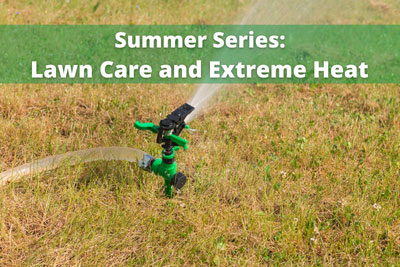Homeowners across the country have endured one of the hottest stretches in recent memory. Few places, it seems, are immune from the extreme heat. And our lawns are the worse for it.
We’ll help you navigate the worst that summer can throw at us in a series of articles and help you manage your lawn and garden in these conditions.
Extreme heat will stress cool-season grasses, such as Kentucky bluegrass and fescues. These grasses are at their best when the temperature is less than 77 degrees. When it’s extremely hot — especially for long periods, the plant is using up energy and not producing it, which will halt the growth of roots and shoots, turn the grass blades yellow or brown, and significantly reduce the quality of the turf.
[Read more in our Summer Series: Part 2 Lawn Care and Drought | Part 3 Lawn Care and Disease]
Warm-season grasses, such as Bermuda and St. Augustine and zoysia grass hold up much better on hot days and do not require the same critical attention during summer heat stress as cool-season grasses do.
IRRIGATING
As with any landscape, watering is, of course, an important factor in the management of your lawn, which we will cover more in-depth in Part 2 of this series on drought. Here we will note that, to help grass cope with excessive heat, water at the start of the hottest days if you can, as thoroughly as you can.
MOWING
It is important to keep up your regular mowing schedule. Never remove more than one-third of the grass stem at any one time. Setting your mower at a higher level will leave taller blades of grass, which will help keep the turf canopy cool.
Avoid the trap of delaying mowing and then scalping because this actually promotes grass growth and will kick off a cycle of fast growth, more scalping, additional growth and on and on. This cycle weakens the health of your turf and creates an environment for more weeds in your lawn.
FERTILIZING
Pay close attention to the fertilizer you intend to apply to your lawn. Warm-season species, which thrive in the heat, benefit from some nitrogen fertilization.
 For cool-season lawns, it is critical to use a slow-release or organic nitrogen fertilizer application in summer; quick-release fertilizers will burn the turf and promote disease (which we’ll cover in Part 3 of this series).
For cool-season lawns, it is critical to use a slow-release or organic nitrogen fertilizer application in summer; quick-release fertilizers will burn the turf and promote disease (which we’ll cover in Part 3 of this series).
Older, long-established lawns typically have enough nitrogen already stored in the soil and a fertilizer application is unnecessary. Wait until late summer or early fall before applying fertilizer.
Although a wilted lawn damaged in extreme heat does look bad, in most cases the turf will recover with rainfall, irrigation, and cooler temperatures.
Your local independent lawn and landscape dealer can give you advice on any specific problems or concerns that you have. They can also recommend reputable landscapers who can test the quality of your soil, provide the proper nutrients, and give you expert advice on how to keep your lawn looking great. To find a dealer near you,

